Brand strategy is key to survival for any brand. The problem is many organisations fail to take the time and put in the effort to develop their brand strategy. Or they don’t understand what a brand strategy is and why it is of crucial importance. (Hint: it’s not your logo).
Think about the first time you met someone. What do you remember? You might remember what they were wearing, if it was something particularly notable. You might remember what they said, if it was poignant or controversial. But what you will always remember is how they made you feel.
This is what brand strategy is about. Beyond how you look or what you have to offer, it guides the entirety of everything that represents your business.
Over the years I have developed a strategic framework for building brand strategies. I’m going to share it with you here and explain how you can go about developing your brand strategy.
What is brand strategy?
First, we need to set a definition for what a brand is. It’s not your logo, or your product. It’s not your mission statement. Your brand is your reputation, it’s how people feel about your product, service, or company – the emotional connection. It is what sets you apart. It encompasses what you have to offer and why you do what you do.
A brand strategy is a blueprint for how you will create your brand – how you will convey what you stand for and why you exist in everything that you do.
Why do you need a strategy?
Think about the America’s World Cup. Teams spend months planning their strategies, training their teams, and optimizing their equipment. Watching them race is almost other-worldly, with boats that barely touch the water reaching unbelievable speeds. Now imagine you go out there in a boat, all by yourself, thinking you’ll figure out how to compete.
You paddle one direction, then another, always looking for the magic spot where you’ll get ahead. You might even ride the wake of one of the boats for a while – what a trip! But it can’t last for long. You’ll be left dizzy and alone while the others celebrate their performance – and strategize for their next run.
That’s essentially what you’re doing if you don’t have a brand strategy. You may as well paddle your sorry defeated self back to shore and get out of the way.
Your brand strategy is a cohesive blueprint that guides your decisions. It creates a plan of action so that you know what to do and when to do it. It is how you execute your brand.
A brand strategy encompasses:
Who you are,
What you have to offer,
Where you’re going,
How you will communicate, and
Why you exist.
The framework I use for brand strategy development will help you narrow down each of these points to create your own brand strategy.
Before you start the process
There are a couple of things you need to put in place before we start with the brand strategy framework.
Who are your customers?
To communicate in the best way, you need to know your audience. Who are your customers? What is their life like? What’s it like to walk in their shoes?
Imagine what they think about, what they worry about, and what they want to achieve. Where do they live? Who do they listen to –their friends, their boss, social media? Are they moving away from pain, or towards gains? Develop personas that represent your customer so you can communicate with them in a way that shows empathy.
Who is your competition?
Assess who you’re up against. What do they do better than you? Where are they failing? What can you learn from them?
Most importantly, how do you stand out from your competition? Finding your point of radical difference identifies your niche – the spot no one else owns. This is what you want to focus on communicating to your audience.
HOW TO BUILD A BRAND STRATEGY
Now for the good stuff. There are three key areas of our “Brand Strategy on a Page” Framework as you can see in the example below. I’ll walk you through each of these areas to help build your brand strategy.

Identify Your Brand
The first step in building your brand strategy is in the ‘Heads & Hearts’ arena. What’s your brand’s identity? You have a purpose, a vision, values, and beliefs that you stand for. Your raison d’etre. Your brand’s heart.
In a previous article, I referred to Simon Sinek’s definition of a brand purpose. He said, “People don’t buy what you do; they buy why you do it.” Your purpose isn’t the same as your mission statement or your vision statement, but it encompasses both.
First, define your vision and mission. What do you see for the future, and how will your brand help create it? How will you solve your customer’s problems?
Next, your values. What principles will guide every aspect of your brand’s behavior? Today’s consumers want to do business with brands they can believe in. Being authentic in your values shows where your priorities lie and communicates that you will walk the talk.
Third, your beliefs. What do your brand stand for? What are you committed to?
When boring is anything but
New Zealand based company Boring Milk creates oat milk. Founder Morgan Maw sees a future that is less reliant on dairy and more focused on plant-based foods. She values NZ’s beautiful landscapes and is committed to making a difference in farming and land use. She thinks oats are the answer and spent 3 years working hard to get oat milk made in NZ with oats grown in Otago and Southland. Oat crops rejuvenate the soil, don’t require much water and are a familiar part of Kiwi diets. When it comes to branding, she says that milk isn’t meant to be the star; it is always the supporting actor to coffee, cereal, or porridge. The Boring Milk brand certainly lives out the founder’s vision, mission, values and beliefs – with clever no-frills marketing to go with it.
Align Your Messaging
Here we get to the ‘Walking & Talking’ sector. Here we make sure that what is in your heart aligns with your messaging and visuals.
Consistency in messaging is crucial because it builds brand awareness. Take a look at your current messaging – is it consistent across channels? Is every message easily identifiable as being part of your brand, whether it is a social media post, advertisement, or web page? Does it reflect your brand’s identity?
You have established your identity; how will you live it? Working through this area helps you develop guidelines for behaviour for all aspects of your business. You can develop a brand playbook, a guiding document for staff to use when making decisions and interacting with others on behalf of the brand.
Here’s how to do it:
HOW WE BEHAVE Narrow down your brand personality. Describe your brand as if it were a person. Are you funny, casual, and hip? Or serious, formal, and conservative? Vivacious or introverted? Are you someone who wears a suit and tie or comes to the office in jandals and shorts?
HOW WE TALK Nail your voice and tone. Consistency is key – this is the personal touch to your communications. It helps maintain the image of your culture. Imagine if Nike suddenly came out with an ad that encouraged blending in with the crowd and not making a statement. Everyone would likely be taken aback at the contradiction to their established messaging around ‘Just Do It.’ Your brand needs the same strong identifying voice and tone. Establishing your brand’s stories is an excellent place to start.
HOW WE LOOK Design your visuals. Put your brand’s personality into visual elements of colour, logo, and font.
Colour: Between 62% and 90% of a person’s initial judgment of a product is based on colour alone. It is one of the first things people see about your brand. Use it to stand out (see “What colour is right for your brand?”)
Logo: Don’t overcomplicate things. Your logo needs to be memorable, and usually simplistic images stamp themselves in our minds more readily than complex ones.
Font: Your choice of font sends an instant message. It can communicate playfulness or rigidity and strength, be modern or vintage, have a streamlined look or a soft, romantic side. Make sure you’re making the right impression.
Nike walks the talk
Speaking of Nike and their ‘Just Do It’ messaging, they provide a perfect example of how consistency in messaging stakes out your brand’s identity. When American football star Colin Kaepernick took a knee rather than standing for the country’s National Anthem to protest police brutality and racial inequality, it created a huge controversy in the States, with then-president Donald Trump calling for protesting players to be fired. Kaepernick took a stand for what he believed in, and Nike stood by him. Nike created an ad with Kaepernick’s face that aligns with what their brand stands for with simple, clear messaging. The ad didn’t show any products or even say Nike, but everyone who saw it would know who it was from. They stood true to their values, even though it meant that some people took to burning their Nikes or cutting their logo off – their true customers bonded even more strongly.
Former San Francisco 49ers quarterback Colin Kaepernick features in this Nike as for the 30th anniversary of the “Just Do It” campaign, reflecting Nike’s brand strategy of standing by their values.

Position Your Brand
This is where you put your brand’s position in concrete. The ‘Proof & Pudding.’
Where do you stand in regard to your competitors? Do you have a better product, or perhaps you were the first in your category? Do you have something revolutionary, or a better price? Which avenue you take depends on your audience and what they want.
Your content marketing strategy plays a major role here. You can establish your position in the market and offer up proof through case studies and testimonials. By staying true to your brand identity, you will foster engagement and brand loyalty.
Every piece of content should tell your brand story. This enables you to connect on an emotional level, making your brand more human. Storytelling connects with our brains and releases chemicals that motivate us and influence our behaviour. Stop selling to people and start connecting instead.
Cheeky Clean and… cheeky
There is a new small company in NZ that I think is doing a brilliant job with their brand’s ‘Proof & Pudding.’ Cheeky Clean toilet paper spray is an all-natural, eco-friendly alternative to wet wipes. They are on a mission ‘to clean bums and unclog drains.’ They believe in ‘smooth, satisfying and sustainable wiping.’ They say Cheeky Clean is ‘gentle on your bits, easy on the earth and small enough to carry in your pocket.’ They tell an excellent brand story. They even have customer testimonials, yes people who tell about their experience with toilet paper spray. Cheeky Clean’s voice and cheeky tone is evident throughout all their messaging. Especially their tagline, “For us, for you, for people who poo.” Even their logo resembles… well, you can look for yourself.

Ad for Cheeky Clean from the company Facebook page represents their brand strategy.
Bring It All Together
Your brand strategy is what will enable you to leave a lasting impression at each interaction with your audience. Remember, more than how you look or what you offer, it’s how you make them feel. Whether you want them to feel amused, outraged, curious or informed, you can elicit those feelings and associate them with your brand through consistent representation. Your brand strategy forms the basis of what you stand for and why you exist and guides you to a strong execution.
I hope this has helped you start your path to building your brand strategy. Of course, this doesn’t mean the job is done. You need to implement the strategy and fully commit to it. You’ve got the tools, now put them to work.
Contact Steve today for a free brand audit to see if your brand strategy is hitting the mark.

